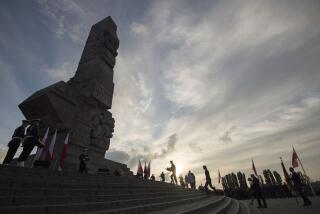A Tale of Two Royal Gravesites
- Share via
YEKATERINBURG, Russia — Fanciful log churches sprout like mushrooms in the deep woods outside this industrial city. Anatoly Kozhayev shuffles between them, his bushy gray hair and beard giving him a more than passing resemblance to a troll.
The pilgrim and tour guide surveys the churches’ curvy green roofs and shiny copper domes and sighs with satisfaction. “Isn’t this a fairy tale?” he asks.
Just three years ago, this wood held little more than mosquitoes and secrets. Here, in two abandoned mine shafts, Bolshevik gunmen first buried the remains of the murdered Romanov royal family--Russia’s last czar, Nicholas II, his wife, five children and four companions.
The Russian Orthodox Church has canonized the Romanovs and is building a monastery in the woods to commemorate their burial. Seven churches are planned to honor the seven royal victims; five of the structures are already built. The largest of them, St. Nicholas, has 17 onion domes, in honor of July 17, the day the royals died.
But some visitors, especially those with a secular bent, might be confused by a second Romanov burial memorial just a mile or so away at a spot known as Porosyonkov Log. The second site, alongside a railway track and marked by a modest black cross, has a marble plaque declaring that the czar and his family were buried there.
The competing burial sites demonstrate that when it comes to the executed Romanovs, secular politics and religious politics have yet to make their peace.
For those who put their faith in science, there is little doubt that the skeletons pulled from a watery hole at Porosyonkov Log are those of the Romanovs. DNA from the skeletons, tested by several Western laboratories with a reliability higher than 99%, was linked to the Russian royal family.
Moreover, the site and condition of the remains were consistent with descriptions written by the royal family’s killers. They said they took the bodies and put them in a mine shaft in a place called Ganina Yama but exhumed them the next day for fear locals would find the spot. They found a more obscure site, Porosyonkov Log, burned two of the corpses to ash and buried the rest.
The remains were discovered there by amateur sleuths in 1979 and exhumed in 1991. The Russian government buried them in the royal crypt in St. Petersburg in 1998.
Four years later, the Russian Orthodox Church’s position on the bones remains unchanged.
“They still don’t accept the results of our investigation and prefer to wait for some new evidence to materialize,” says Vladimir N. Solovyov, the senior prosecutor who headed the government investigation. “But frankly, I don’t see what else can emerge in the case which would make them change their decision.”
Indeed, the enormous woodland Monastery of the Royal Passion Sufferers is being built on the basis of a far earlier probe--that of Nikolai Sokolov, a pro-monarchist investigator, who discovered Ganina Yama after anti-Bolshevik troops took the area in 1918. Sokolov concluded that the bodies had been all but destroyed at the site and if there were any remaining ash and bones, they were tossed into the mine shafts or scattered in the woods.
Consistent with the Sokolov conclusion, the centerpieces of the new monastery are the mine shafts--now just grassy depressions--encircled by a roofed viewing platform. Pilgrims kneel at crosses placed randomly through the woods, because, according to this version of events, the royal family’s remains may be anywhere.
“I think the church has a perfect right to build a monastery at this location commemorating the death of the czar’s family, because the earth there was also stained with the royal family’s blood,” Solovyov says.
Kozhayev and other believers are little bothered by the DNA evidence suggesting that the Romanov remains were buried elsewhere. He finds faith far more persuasive.
Standing near the shafts, the tour guide points to a tall, thick birch and a lithe pine tree growing near the holes. “Those are the czar and czarina,” he says. Then he points to an immature birch and a small stand of four birches on the opposite side. “The czarevitch and the four daughters,” he says. “The landscape itself testifies that this is a holy place.”
Believers such as Kozhayev have been very influential in the debate over the czarist remains. Sometimes swayed by nationalist or chauvinistic ideologies, they were suspicious of any investigation that they believed was tainted by Communist-era evidence.
For instance, Kozhayev offers the following explanation for the second burial site: “The czar had a double. So did the whole family, for security. Even the bodyguards didn’t know which was the right one. To get money from the West, [the government] had to find the czar’s remains. So they said the doubles were the real ones.”
Despite the prevalence of such views at Ganina Yama, the opinions of many in the church appear to be softening, says Sergei Chapnin, editor of Moskovsky Tserkovny Vestnik, an official church publication.
“With time, it is becoming more evident that the government investigation was conscientious and that the protests against it were based more on politics and ideology and were largely without merit,” Chapnin says.
The official church position, he says, is that only time will tell whether the exhumed bones are authentic royal remains.
“The church already has a significant number of people who consider the remains authentic, who believe the conclusion of the government commission and consider the bones buried in St. Petersburg to be holy relics,” Chapnin says. “It’s fully possible that we could return to this discussion in the future, perhaps even in the near future.”
Sergei L. Loiko of The Times’ Moscow Bureau contributed to this report.
More to Read
Sign up for Essential California
The most important California stories and recommendations in your inbox every morning.
You may occasionally receive promotional content from the Los Angeles Times.













